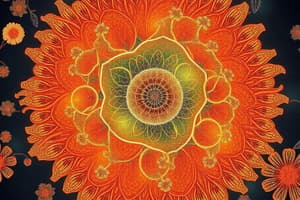Podcast
Questions and Answers
What is the primary function of the nucleus in a cell?
What is the primary function of the nucleus in a cell?
- Produces ATP molecules for energy.
- Contains the DNA and controls all functions of the cell. (correct)
- Separates ribosomes from the cytoplasm.
- Synthesizes lipids and detoxifies the cell.
Which organelle is primarily responsible for synthesizing proteins?
Which organelle is primarily responsible for synthesizing proteins?
- Nucleolus
- Mitochondrion
- Rough E.R. (correct)
- Smooth E.R.
Where is the chromatin located in a cell?
Where is the chromatin located in a cell?
- In the cytoplasm.
- Inside the nucleus. (correct)
- Inside the mitochondrion.
- Surrounding the cell membrane.
What is the primary function of the mitochondrion?
What is the primary function of the mitochondrion?
Which of the following describes the Smooth E.R.?
Which of the following describes the Smooth E.R.?
What is the primary function of lysosomes in the cell?
What is the primary function of lysosomes in the cell?
Which structure is responsible for packaging and tagging molecules for transport?
Which structure is responsible for packaging and tagging molecules for transport?
What role do peroxisomes play in the cell?
What role do peroxisomes play in the cell?
Which component of the cytoskeleton is primarily responsible for cell shape and transport?
Which component of the cytoskeleton is primarily responsible for cell shape and transport?
What is the main function of the plasma membrane?
What is the main function of the plasma membrane?
Which of these is not a component of plant cells?
Which of these is not a component of plant cells?
Which organelle is involved in photosynthesis?
Which organelle is involved in photosynthesis?
What is the primary function of chromoplasts in plant cells?
What is the primary function of chromoplasts in plant cells?
Which organelle serves as a storage unit within the cell?
Which organelle serves as a storage unit within the cell?
Which structure is responsible for propelling the cell through fluid?
Which structure is responsible for propelling the cell through fluid?
Which of the following is the function of the central vacuole in plant cells?
Which of the following is the function of the central vacuole in plant cells?
What role do microvilli play on the cell surface?
What role do microvilli play on the cell surface?
What is the function of the contractile vacuole in protists?
What is the function of the contractile vacuole in protists?
Which structure is mainly involved in cell division?
Which structure is mainly involved in cell division?
Flashcards are hidden until you start studying
Study Notes
Cell Organelles Overview
- Nucleus ("The Boss"): Usually central in the cell, controls all cell functions; contains DNA.
- Nuclear Membrane: Surrounds the nucleus, contains nuclear pores for selective molecule passage.
Genetic Material and Ribosomes
- Chromatin ("The Blueprints"): Found inside the nucleus, consists of proteins and DNA, holds genetic instructions for synthesizing molecules.
- Nucleolus: Located within the nucleus, responsible for synthesizing ribosomes.
Energy Production and Protein Synthesis
- Mitochondrion ("The Powerhouse"): Located in the cytoplasm, produces ATP via aerobic respiration, essential for energy.
- Rough Endoplasmic Reticulum (Rough E.R.): In the cytoplasm, synthesizes proteins.
- Smooth Endoplasmic Reticulum (Smooth E.R.): In the cytoplasm, synthesizes lipids and detoxifies the cell.
- Ribosomes: Present attached to Rough E.R. and free in the cytoplasm, synthesize proteins.
Packaging and Transport
- Golgi Apparatus ("UPS"): Located in the cytoplasm, packages produced molecules into vesicles and tags them for transport.
- Lysosome ("The Stomach"): Contains digestive enzymes, breaks down contents when merging with other vesicles.
- Peroxisome: In the cytoplasm, breaks down fatty acids and substrates through oxidative reactions.
- Vesicles ("Storage Unit"): Membrane-bound sacs in the cytoplasm, store or transport molecules.
- Secretory Vesicles: Merge with the plasma membrane to release molecules outside the cell.
Structural Support and Cell Shape
- Plasma Membrane (Cell Membrane): Surrounds the cell, selectively permeable, regulates passage of materials.
- Cytoskeleton ("The Skeleton"): Composed of protein filaments and microtubules, provides shape and assists in vesicle transport.
- Microtubules: Provide support and structure, component of centrioles, cilia, and flagella.
Cell Movement and Division
- Centrioles: Composed of microtubules, play a role in cell division.
- Cilia: On the cell surface, beat back and forth to move fluid across the cell.
- Flagella ("The Tail"): Protrudes from the cell, whips to propel the cell forward; typically one per sperm cell.
Additional Structures in Plant Cells
- Microvilli: On cell surface, increase surface area.
- Contractile Vacuole: In cytoplasm of protists and some fungi, expels water to prevent cell rupture.
- Cell Wall: Covers plant cells, prevents rupture from water pressure.
- Plastids: Cytoplasm of plant cells, includes chloroplasts, leucoplasts, amyloplasts, and chromoplasts.
- Chloroplasts: Site of photosynthesis, contains chlorophyll to absorb sunlight for glucose synthesis.
- Chromoplasts: Store color pigments, typically yellow or orange.
- Amyloplasts: Site for starch storage.
- Central Vacuole: Center of plant cells, provides pressure against the cell wall for support.
Studying That Suits You
Use AI to generate personalized quizzes and flashcards to suit your learning preferences.




